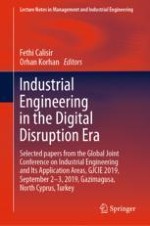2020 | Buch
Industrial Engineering in the Digital Disruption Era
Selected papers from the Global Joint Conference on Industrial Engineering and Its Application Areas, GJCIE 2019, September 2-3, 2019, Gazimagusa, North Cyprus, Turkey
herausgegeben von: Fethi Calisir, Orhan Korhan
Verlag: Springer International Publishing
Buchreihe : Lecture Notes in Management and Industrial Engineering
